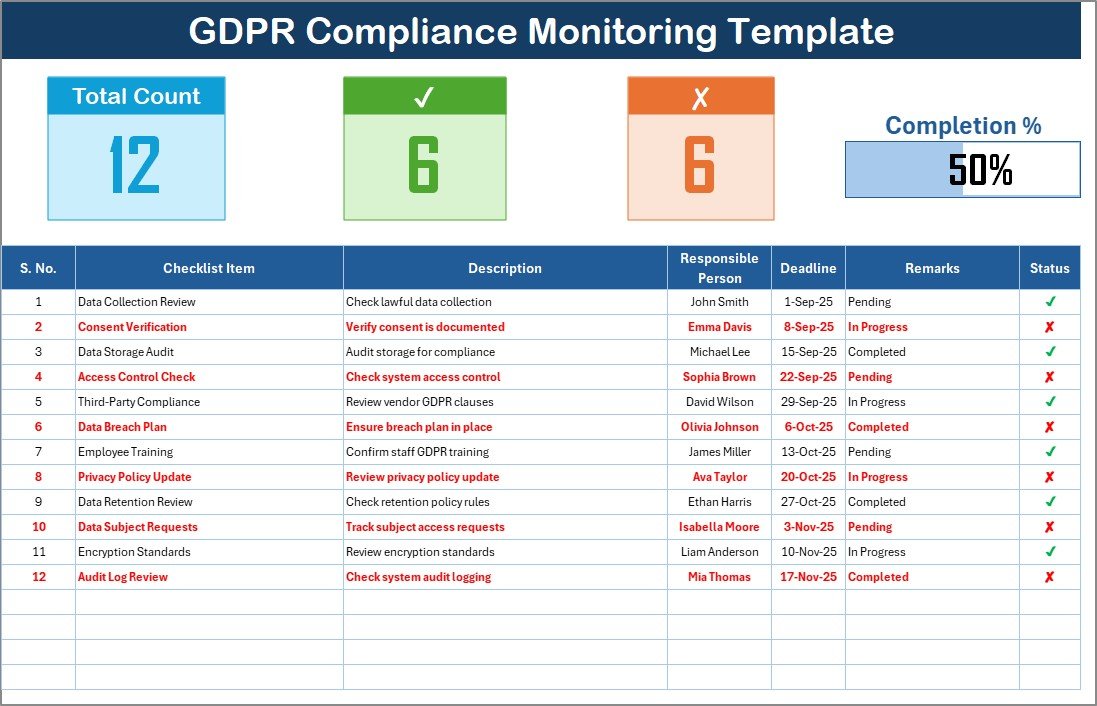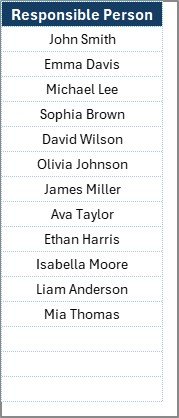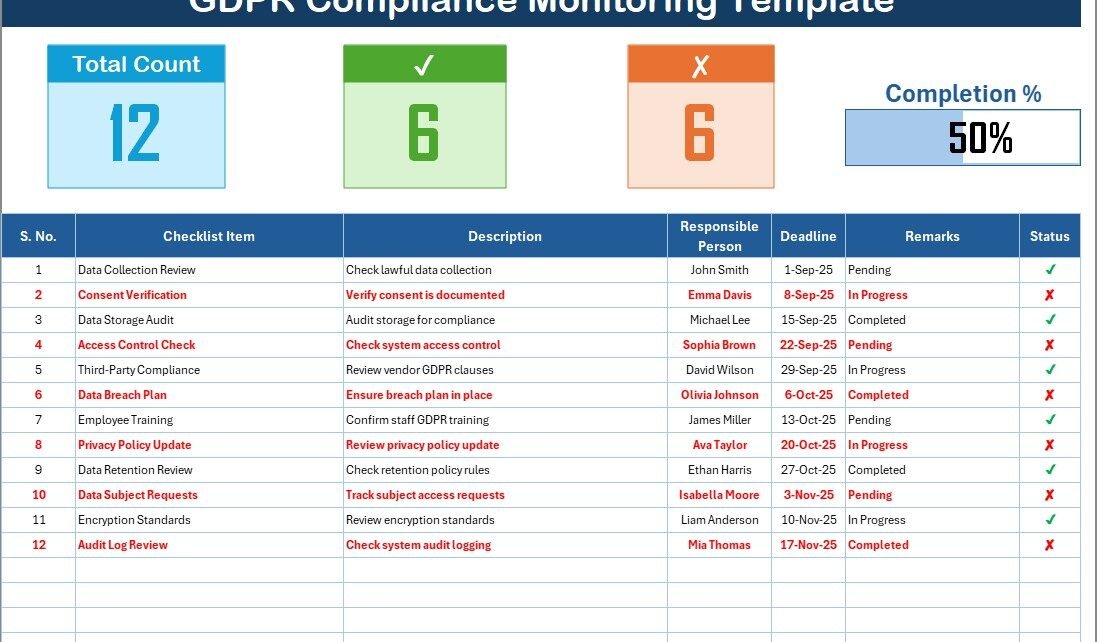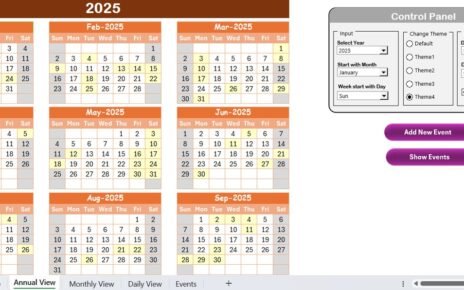The General Data Protection Regulation (GDPR) has transformed the way businesses handle personal data. Organizations across industries must ensure that customer information remains secure, transparent, and compliant with strict EU regulations. While many companies invest in complex compliance software, a simpler, cost-effective, and highly flexible solution exists—GDPR Compliance Monitoring in Excel.
Excel is one of the most accessible tools available today. With the right structure, businesses can build a compliance checklist, assign responsibilities, and monitor progress in real-time. This article explores how Excel can serve as a GDPR compliance monitoring tool, what features to include, and how organizations can benefit from using it effectively.
Click to Purchases GDPR Compliance Monitoring Check List in Excel
What is GDPR Compliance Monitoring in Excel?
GDPR compliance monitoring in Excel refers to the process of tracking, documenting, and evaluating data protection measures using structured Excel templates. It provides a centralized view of compliance tasks, helping teams stay organized and accountable.
Instead of relying solely on expensive GDPR tools, companies can use Excel to:
-
Record compliance requirements.
-
Assign tasks to responsible persons.
-
Set deadlines and track completion.
-
Monitor progress using built-in formulas and charts.
This approach works best for small to mid-sized organizations, but even large enterprises can use it as a supporting tool.
Key Features of the GDPR Compliance Monitoring Template
A GDPR compliance monitoring template in Excel is structured into two main worksheets:
GDPR Compliance Monitoring Sheet

This is the main sheet where compliance activities are tracked.
Top Section
-
Displays Total Count, Checked Count, Crossed Count, and a Progress Bar.
-
Helps users instantly view the percentage of completed compliance tasks.
Checklist Table
This table includes essential columns:
-
Serial No. – For easy tracking of tasks.
-
Checklist Item – The GDPR activity to monitor.
-
Description – A short explanation of the requirement.
-
Responsible Person – The team member in charge.
-
Deadline – Completion date for the activity.
-
Remarks – Notes or updates.
-
Status – Marked as ✔ or ✘ to indicate progress.
List Sheet Tab

-
Captures the unique list of responsible persons.
-
Enables dropdown menus in the main sheet for assigning tasks.
-
Ensures consistency when multiple people manage compliance.
Why Use Excel for GDPR Compliance Monitoring?
Many organizations already rely on Excel for project management, reporting, and analysis. Using Excel for GDPR compliance monitoring provides:
-
Cost savings – No need for expensive compliance software.
-
Flexibility – Customize the template to match business needs.
-
Ease of use – Most employees are familiar with Excel.
-
Accessibility – Files can be shared via email, cloud, or Microsoft Teams.
-
Automation – Formulas and conditional formatting simplify reporting.
Advantages of GDPR Compliance Monitoring in Excel
Using Excel as a GDPR compliance tool brings several benefits:
✅ Centralized data management – All GDPR requirements in one place.
✅ Clear accountability – Assigns tasks to specific individuals.
✅ Real-time monitoring – Track progress through dynamic dashboards.
✅ Customizable framework – Adjust checklist items based on regulations.
✅ Visual progress indicators – Progress bar and counts enhance visibility.
✅ Improved collaboration – Easy sharing across departments.
✅ Audit readiness – Maintain structured records for external reviews.
Opportunities for Improvement in Excel-Based Monitoring
Click to Purchases GDPR Compliance Monitoring Check List in Excel
While Excel is powerful, it also comes with some limitations. Organizations should be aware of areas where improvements can be made:
⚠️ Scalability issues – Excel may not handle very large datasets effectively.
⚠️ Manual data entry – Increases the chance of human error.
⚠️ Version control – Multiple users editing can cause conflicts.
⚠️ Limited automation – Compared to specialized compliance tools.
To overcome these, businesses can:
-
Use cloud-based Excel (Office 365 or Google Sheets) for collaboration.
-
Implement data validation and conditional formatting to reduce errors.
-
Integrate Excel with Power BI for advanced reporting.
-
Regularly back up and secure compliance files.
How to Set Up a GDPR Compliance Monitoring Template in Excel
Follow these steps to build a GDPR compliance monitoring sheet:
Step 1: Create the Checklist Table
-
Add columns: Serial No., Checklist Item, Description, Responsible Person, Deadline, Remarks, Status.
Step 2: Insert Dropdowns
-
Use data validation to create dropdown menus for Responsible Person and Status (✔ or ✘).
Step 3: Add Summary Section
-
Insert formulas to calculate Total Count, Checked Count, Crossed Count.
-
Create a progress bar using conditional formatting.
Step 4: Design the List Sheet
-
Capture all unique names of responsible persons.
-
Link this list to the dropdown in the main sheet.
Step 5: Apply Conditional Formatting
-
Color code ✔ as green and ✘ as red for quick visibility.
Step 6: Add Filters and Sorting Options
-
Allow users to filter by deadline, status, or responsible person.
Best Practices for GDPR Compliance Monitoring in Excel
To make the most of your template, follow these best practices:
🔹 Keep the checklist updated – Add new requirements whenever GDPR rules change.
🔹 Assign clear ownership – Each task should have one responsible person.
🔹 Review deadlines regularly – Ensure timely completion of compliance activities.
🔹 Use automation – Apply formulas for percentages, overdue tasks, and reminders.
🔹 Secure your file – Protect sheets and use password access for sensitive data.
🔹 Integrate with dashboards – Connect Excel with Power BI for advanced insights.
🔹 Audit your checklist – Conduct quarterly reviews to maintain accuracy.
Practical Use Cases of GDPR Compliance Monitoring in Excel
Businesses can apply this Excel template in several ways:
-
HR Departments – Track employee data processing and consent management.
-
Marketing Teams – Monitor email opt-ins, customer preferences, and privacy notices.
-
IT Security Teams – Document data breach protocols and security audits.
-
Finance Teams – Manage vendor data processing agreements.
-
Legal Teams – Track compliance with GDPR reporting requirements.
Conclusion
GDPR compliance monitoring in Excel is a practical, flexible, and cost-effective solution for businesses of all sizes. With its structured checklist, progress indicators, and accountability features, organizations can streamline GDPR compliance tasks without heavy investments.
Although Excel has some limitations, when combined with best practices and periodic audits, it remains a powerful tool for ensuring compliance and preparing for audits. Businesses that need more scalability can integrate Excel with advanced reporting tools like Power BI or eventually migrate to specialized compliance systems.
Frequently Asked Questions (FAQs)
1. What is GDPR compliance monitoring?
GDPR compliance monitoring is the process of ensuring that businesses follow data protection regulations by tracking, documenting, and reviewing their data management practices.
2. Why should I use Excel for GDPR compliance monitoring?
Excel is cost-effective, customizable, and familiar to most employees. It helps businesses track compliance requirements without needing expensive tools.
3. Can Excel handle all GDPR compliance needs?
Excel works well for small to medium organizations, but larger businesses may require specialized tools for scalability, automation, and advanced reporting.
4. How do I create a GDPR checklist in Excel?
You can create a table with columns such as Serial No., Checklist Item, Responsible Person, Deadline, and Status. Add formulas for progress tracking and use conditional formatting for better visibility.
5. How often should GDPR compliance checklists be updated?
It is recommended to review and update the checklist quarterly or whenever new GDPR regulations or organizational changes occur.
6. Can I integrate Excel compliance monitoring with other tools?
Yes, Excel files can be connected to Power BI, Microsoft Teams, and cloud storage platforms for enhanced reporting and collaboration.
Visit our YouTube channel to learn step-by-step video tutorials



